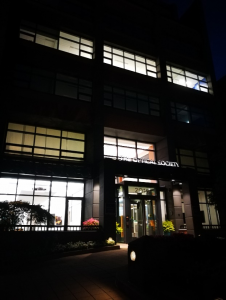FiO 2017 Naotaka Kamioka
Research
OSA FRONTIERS IN OPTICS (FIO) Participation Report
Master1Year: Naotaka Kamioka
Outline
I attended the international conference Frontiers in Optics/Laser Science (FiO/LS) held on September 17~21 in Washington, DC, USA. The conference was organized by the Optical Society of America, and was held annually in various locations in the U.S. However, it seems that the conference will be held at the Hilton Hotel in Washington, DC for the next several years after this year. Although the ratio of poster presentations was higher than that of oral presentations, there were many new attempts such as e-posters using monitors and rapid fire oral presentations in which only selected presentations in each poster session were given a 5-minute summary. I felt that this was one of the reasons for the lively poster presentations.


2. regarding the presentation
I presented a numerical analysis of the amplification of magneto-optical effects using the slow light effect by FDTD and the possibility of improving the performance of optical isolators. I often found myself struggling to understand the intent and content of the English questions, or simply feeling that I did not have enough knowledge. As expected, there were more questions about FDTD than about the results themselves, such as what is used (Lumerical or MEEP?) and how and why it was modified from the conventional method. The presentation was very informative.
3. topic report
I. Palstra, D. Kosters, F. Alpeggiani, and K. Kuipers, "Extreme Twists of Light in Photonic Crystal Waveguides," in Frontiers in Optics 2017, OSA Technical Digest (online) (Optical Society of America, 2017), paper JW3A.54.
In this study, light was made "super-chiral" in an asymmetric photonic crystal waveguide for the purpose of sensing molecules with chirality. By shifting the holes on the sides of the waveguide, a "super-chiral" electric field distribution was obtained, in which the chirality index C, which is ±1 for circularly polarized light, is larger than 1. In ordinary photonic crystal waveguides, the electric field on the side of the waveguide also shows a large chirality of C greater than 1, but because it is symmetrical to the waveguide, the total chirality is 0. The simulation succeeded in obtaining a chirality of 24 times C.
Since the purpose of the poster was material sensing, the poster showed the electric field Ex, Ey, and Ez profiles on 20 nm of a waveguide, but that one showed a large waveguide asymmetric electric field distribution, which I thought might be applicable to the case where magnetic materials are attached on top of a waveguide, as in my research. It was very interesting. He said that he was going to actually fabricate the structure and conduct experiments in the future, but it seemed that he was not very strong in fabricating photonic crystal waveguides, since he reported on his poster that he had fabricated ordinary photonic crystal waveguides and was having difficulty in fabricating the asymmetric proposed structure.
T. Crane, O. Trojak, and L. Sapienza, "High-Q Optical Cavities at Visible Wavelengths in Photonic Crystals in an Anderson-localized regime," in Frontiers in Optics 2017, OSA Technical Digest (online) (Optical Society of America, 2017), paper JW3A.50.
The Q-value of SiN is 10 times higher than that of SiN to the power of 3, because of the criticality of structural imperfections in the longer wavelength region in 2D photonic crystal structures. The Q-value is increased by a factor of 10 by using Anderson localization due to structural imperfections. The reason why they used SiN is because they wanted to see visible light characteristics using photoluminescence of nitride, and in principle, SiN can also be used. In principle, SiN can also be used for this purpose. He also said that if the displacement is too large, out-of-plane reflections increase and Q-value decreases. Although the presentation itself was not very impressive, I learned a lot because I did not have much insight into the visible light range and did not have a deep understanding of Anderson localization.
C. Chen, X. Guo, X. Ni, and I. C. Khoo, "Observation of a New Mechanism for Slowing Femtosecond Pulses by Liquid-Crystalline Chiral Photonic Crystals," in Frontiers in Optics 2017, OSA Technical Digest (online) (Optical Society of America, 2017), paper FW6B.3.
The authors report that they have observed a slow-light effect in laser oscillation with cholestrick liquid crystal photonic crystals that exceeds the effect at the band edge. By setting the laser wavelength in the photonic band gap, not only a large slow-light effect can be obtained, but also pulse broadening can be avoided. Novel Studies of Waveguides, Lasers and Atomic Interactions," which was a session on novel phenomena. However, the slow light effect outside of the band edge, which is usually used in photonic crystal waveguides, was interesting.
- Categories
- 国際会議報告


